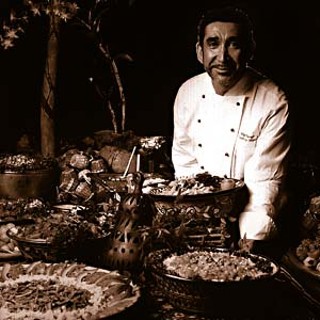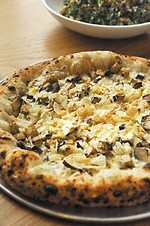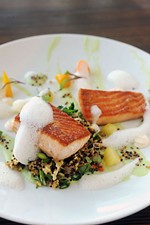Mexican Food 101
Tex-Mex or Interior?
By Virginia B. Wood, Fri., March 6, 2009

For the last half of the 20th century, Austin was known around the country as a prime destination for Tex-Mex food and barbecue. Area politicians and businessmen used the local cuisines in campaigns and promotions, inadvertently helping to build their fame. Graduates of local colleges (my own father included) returned regularly to their favorite local haunts, touting the food to friends and families. Even award-winning Texas novelist Larry McMurtry's early fictional characters made pilgrimages to Austin for binges of Tex-Mex and drinking, and both famous cuisines were often featured at the Johnson White House. The barbecue for which Central Texas is justifiably famous has not changed much over the years, and we'll get to a discussion of that soon enough. On the other hand, Mexican food in Austin has undergone such a transformation in the past 35 years that the distinctions between Tex-Mex food and Interior Mexican food are quickly disappearing.
The Tex-Mex food for which Austin was originally known is an authentic American regional cuisine based on the dishes prepared by generations of Tejanos (Mexicans native to the area before Texas became a republic) and Mexican immigrants, with the agricultural products available to them in this area. The key components of the cuisine that were likely to be found on restaurant menus included whole or refried pinto beans; Spanish (red) rice; chile con carne; corn and flour tortillas; beef, chicken, or cheese enchiladas; cheddar cheese (grated, melted, or mixed with salsa for chile con queso); soft or crispy corn tacos with various fillings; grilled skirt steak known as tacos al carbon or fajitas; nachos (crisp tortilla chips with meat, vegetable, and cheese toppings); fresh jalapeño and serrano peppers, onions, tomatoes, and cilantro; guacamole; fresh table salsa and fried tortilla chips; and sugary pecan pralines or rainbow sherbet for dessert. Some of the local restaurants that popularized Tex-Mex food are the former El Matamoros, Carmen's La Tapatia, and Casita Jorge's and the current Cisco's, El Patio, El Gallo, Matt's Famous El Rancho, El Azteca, Chuy's, Nuevo León, Serranos, Amaya's Taco Village, and Maudie's.
Tex-Mex food completely dominated the Austin culinary landscape until 1975, when two audacious young men dared to open a restaurant featuring authentic dishes from Mexico's interior regions. It took Austinites a couple of years to fully embrace Fonda San Miguel – there was the initial rumble over the "no chips and hot sauce" policy (long since abandoned), many patrons were confused by unfamiliar menu items early on, and it took awhile for folks to become accustomed to enjoying flan at the end of a meal rather than candy or sherbet – but the city's love affair with the elegant, art-filled hacienda endures to this day. Some of the components that set Interior Mexican food apart from Tex-Mex are black turtle beans; white, green, or Spanish rice; a wider selection of both fresh and dried chiles, herbs, tomatillos, and achiote; white cheeses, including Monterey Jack, queso fresco, panela, etc.; more complex sauces, such as moles and pipians; seafood dishes from Mexican coastal regions; corn and flour tortillas; a wider variety of meats such as pork, duck, and venison; and flan for dessert.
Fonda San Miguel was eventually followed by other Interior Mexican restaurants such as Las Palomas, Manuel's, Curra's Grill, Polvos, El Mesón Taquería, and Azul Tequila and more recently by Maria Maria La Cantina and La Condesa. But the success of that one seminal restaurant was one of many factors in the evolution of Austin's overall Mexican food scene. As the dining public became more familiar with a wider variety of Mexican dishes, the imported raw materials necessary to prepare those dishes became more available through area wholesalers and eventually on grocery-store shelves. Tex-Mex restaurants that had long reserved Interior dishes for off-menu specials sold to a few savvy, well-traveled patrons began offering them as regular menu items. Recent immigrants from the rural areas of Mexico readily found jobs in local Mexican restaurant kitchens, bringing the cooking of their native areas with them and creating a mixture of styles on many menus. Immigrants with an entrepreneurial spirit created their own livelihoods by selling the traditional street foods of Mexico to their compatriots and hungry Anglos alike via portable taco trucks.
These days, Austin boasts an embarrassment of riches where Mexican food is concerned, but the lines between the old-school Tex-Mex and dishes from the various regions of Mexico are more blurred than ever. Restaurant patrons may even be more likely to find tacos al pastor dressed with chopped onion, cilantro, and lime than they are a crispy taco filled with seasoned ground beef, chopped lettuce, tomato, and grated cheddar cheese on local menus. There are white-tablecloth Mexican restaurants, Texas-based fast-food chains, Mexican seafood restaurants, little family operations where it's possible to identify the owner's Mexican home state by some of the menu items, and taco trucks galore. Visitors to Austin could eat in a different Mexican restaurant three meals a day for a week and not scratch the surface of the culinary riches we have to offer. Most of us locals have a circuit of places we love and frequent regularly. And although an honest plate of true Tex-Mex enchiladas, oozing melted yellow cheese and slathered with chile con carne, may be a little harder to find these days, I assure you, it's still out there. Don't let anyone tell you that's not "real" Mexican food.












